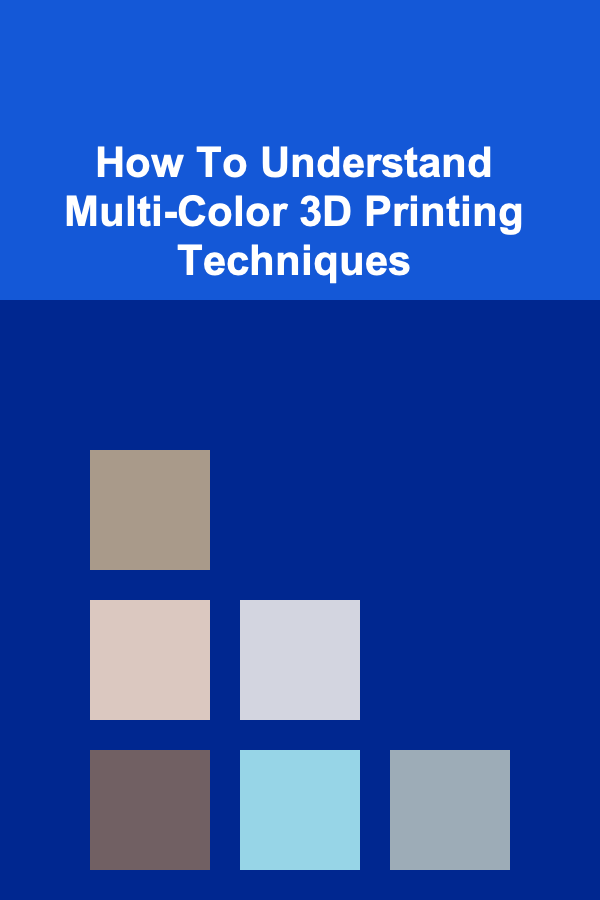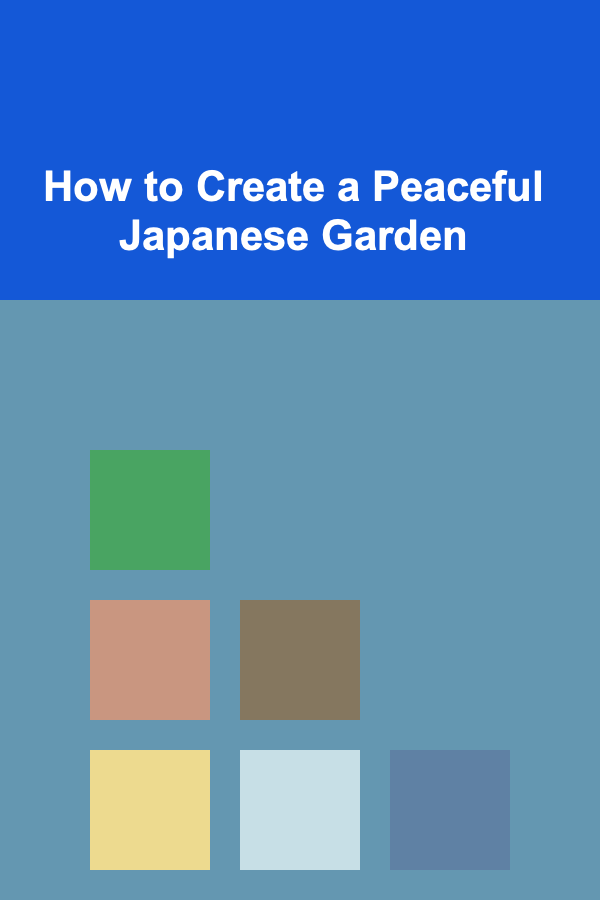
How To Understand Multi-Color 3D Printing Techniques
ebook include PDF & Audio bundle (Micro Guide)
$12.99$8.99
Limited Time Offer! Order within the next:

3D printing, or additive manufacturing, has become one of the most revolutionary technological advancements in recent years. It allows for the creation of physical objects from digital models, layer by layer, using various materials. The process has evolved, with many techniques being developed to improve the quality, complexity, and capabilities of 3D-printed objects. One such advancement is multi-color 3D printing, which enables the production of objects with multiple colors or materials in a single print job.
Understanding multi-color 3D printing techniques requires an exploration of the technology, its applications, and the methods that allow for the integration of different colors or materials during the printing process. In this article, we will delve deep into the principles behind multi-color 3D printing, different types of techniques, challenges, and their applications in various industries.
What Is Multi-Color 3D Printing?
Multi-color 3D printing is a process where different colors or materials are combined in a single 3D printed object. This process can produce objects with more visual appeal and functional complexity. Multi-color printing can be achieved in a variety of ways, including the use of multiple print heads, multi-material filament spools, or advanced post-processing techniques.
While single-color 3D printing uses one material (usually a single-colored filament or resin) throughout the printing process, multi-color printing adds complexity by introducing different colors and sometimes different types of materials. The ability to print in multiple colors allows designers to create more intricate models, enhancing both their aesthetic and functional characteristics.
The Technologies Behind Multi-Color 3D Printing
Multi-color 3D printing can be realized using different technologies, each with its own set of capabilities and limitations. Understanding these technologies is key to comprehending how multi-color 3D printing works.
1. Fused Deposition Modeling (FDM)
Fused Deposition Modeling (FDM) is one of the most common and widely accessible 3D printing methods. In this process, a filament is heated to its melting point and extruded through a nozzle to create a printed object. FDM printers typically work with thermoplastic materials such as PLA, ABS, and PETG.
To achieve multi-color printing with FDM, several techniques can be employed:
- Single Extruder with Color Switching: Some FDM printers have a single extruder but can switch between multiple filaments during the print. This process involves pausing the print and changing the filament spool when a color change is needed. The printer then resumes printing with the new color. This method is suitable for simple prints with few color changes.
- Dual or Multi-Extruder Systems: More advanced FDM printers use multiple extruders, allowing them to print with multiple filaments simultaneously. Each extruder can be loaded with a different color or material, and the printer can switch between extruders to deposit the respective colors. This approach allows for more complex multi-color designs and reduces the need for manual intervention during printing.
- Color Mixing Nozzles: Some advanced FDM printers are equipped with specialized nozzles that can mix filaments before they are extruded. This method allows for gradient color transitions or the creation of entirely new colors by mixing different filament types in real-time.
2. Stereolithography (SLA) and Digital Light Processing (DLP)
Stereolithography (SLA) and Digital Light Processing (DLP) are resin-based 3D printing technologies that work by curing layers of liquid resin with ultraviolet (UV) light. These technologies are known for their high precision and ability to produce highly detailed objects.
In multi-color SLA or DLP printing, different techniques are used to incorporate color into the print:
- Multi-Resin Printing: Some SLA and DLP printers can print with multiple types of resins, including resins of different colors. This can be achieved through sequential resin switching or using resin cartridges of different colors. The printer uses a series of light-based curing steps to solidify the resin layer by layer.
- Post-Processing: Unlike FDM, SLA and DLP printers often rely on post-processing techniques to achieve multi-color effects. After the object is printed in a single color or resin, additional coloring steps are done through airbrushing, dipping, or using other methods to add color. This approach allows for greater flexibility in color selection but requires more time and manual effort.
3. Selective Laser Sintering (SLS)
Selective Laser Sintering (SLS) uses a laser to sinter powdered material, typically nylon, into solid structures. The laser selectively heats the powder, causing it to fuse and form a solid layer. Multi-color printing in SLS is less common compared to FDM or SLA but is still possible in some cases.
- Powder Mixing: In some cases, multiple colored powders can be mixed, and the laser can be used to selectively sinter different colored powders in different areas of the model. This can result in multi-colored prints, although the level of color control is typically less precise than other methods.
- Post-Processing: Similar to SLA and DLP, multi-color SLS prints often involve post-processing techniques such as dyeing the printed object or painting it. This allows for more detailed and vibrant color applications after the print is completed.
4. Inkjet 3D Printing
Inkjet 3D printing is a relatively new method of 3D printing, where liquid materials (such as resin or ink) are jetted onto a surface layer by layer. Inkjet printers use a series of nozzles to deposit droplets of material, and multi-color printing can be achieved by using different inks or resins in separate print heads.
- Full-Color Printing: Some inkjet-based 3D printers, such as the ones used in the production of models or prototypes, can print in full color by combining different colored resins or powders. These printers work similarly to traditional 2D inkjet printers but in three dimensions.
- Binder Jetting: This is a type of inkjet 3D printing where colored powders are bound together using a liquid binder. The printer can use different binders to create multi-colored objects, which are then sintered to create the final product.
Applications of Multi-Color 3D Printing
The ability to print in multiple colors and materials has opened up a wide range of possibilities across various industries. Multi-color 3D printing is not only useful for aesthetics but also for functional purposes. Here are some notable applications:
1. Prototyping and Product Design
Multi-color 3D printing is widely used in product design and prototyping. The ability to print prototypes with different colors allows designers to visualize their products in a more realistic way, simulating how they will appear in the final product. For instance, in consumer electronics, multi-color prototypes help design teams evaluate the visual and tactile aspects of products like smartphones, wearables, and other gadgets.
2. Automotive Industry
In the automotive industry, multi-color 3D printing is used to create both prototypes and functional parts. The ability to print with different materials enables the production of parts with varying mechanical properties, such as flexible or rigid sections, within the same object. Automotive manufacturers use this technology for rapid prototyping, testing, and even small-scale production runs of parts.
3. Medical and Healthcare
In the medical field, multi-color 3D printing has been used to create highly detailed anatomical models for pre-surgical planning. For example, doctors can use multi-color prints to create lifelike models of organs and tissues, allowing them to practice complex procedures before operating on real patients. Additionally, prosthetics can be customized with multi-color 3D printing, offering better aesthetics and comfort for patients.
4. Fashion and Jewelry
Multi-color 3D printing has revolutionized the fashion and jewelry industries. Designers can now create intricate patterns, textures, and color gradients for garments and accessories. 3D-printed jewelry, for instance, can feature multiple colors and textures that would be difficult to achieve using traditional manufacturing methods. This also allows for more personalized and custom designs, enabling customers to have bespoke pieces made on demand.
5. Architecture and Construction
Architects use multi-color 3D printing for creating detailed models of buildings and structures. The ability to print with different materials and colors allows architects to showcase their designs more effectively. Multi-color prints provide a more realistic representation of how a building or structure will look once completed, aiding in presentations and client meetings.
6. Education and Research
Multi-color 3D printing is also being used in education and research. Students and researchers can print models of complex systems, biological organisms, and even historical artifacts in multi-color to better understand their structure and function. These models are more engaging and interactive than traditional 2D diagrams, allowing for hands-on learning experiences.
Challenges and Limitations of Multi-Color 3D Printing
Despite the advantages, there are several challenges and limitations associated with multi-color 3D printing:
- Material Compatibility: Not all materials are compatible with each other in multi-color printing. Some materials may have different melting points, viscosities, or other properties that make it difficult to print them together. This can lead to issues such as clogging, poor adhesion, or material separation.
- Print Quality: Achieving high-quality prints with consistent color transitions can be challenging, especially when using methods like filament switching or mixing. There may be visible lines or inconsistencies in the color distribution, leading to less polished results.
- Cost and Accessibility: Multi-color 3D printers, especially those with multiple extruders or advanced color mixing capabilities, tend to be more expensive than single-extruder models. This makes multi-color 3D printing less accessible to hobbyists or small businesses, especially when compared to other 3D printing methods.
- Post-Processing Time: While multi-color printing can reduce the need for manual intervention during the print process, it often requires additional post-processing steps. These can include cleaning, painting, or assembling the printed parts, which increases the overall production time.
Conclusion
Multi-color 3D printing has undoubtedly expanded the creative and functional possibilities of 3D printing. From prototyping to manufacturing, it has become an indispensable tool in various industries, enabling the creation of more detailed, vibrant, and functional objects. The different multi-color printing techniques---whether using multiple extruders, color mixing nozzles, or inkjet systems---offer distinct advantages and limitations, which need to be understood to choose the best method for a particular application.
As the technology continues to evolve, it is likely that multi-color 3D printing will become more accessible and refined, opening the door to even more innovative applications and creative solutions. Whether for art, industry, or education, multi-color 3D printing will continue to shape the way we design, create, and manufacture objects in the years to come.

How to Budget for Home Utilities and Unexpected Costs
Read More
How to Build a Family Memory Jar to Celebrate Milestones
Read More
How To Cope with Depression: Psychological Strategies
Read More
How To Take Amazing Travel Photos
Read More
How To Engage in Wildlife Rehabilitation Volunteering
Read More
How to Create a Peaceful Japanese Garden
Read MoreOther Products

How to Budget for Home Utilities and Unexpected Costs
Read More
How to Build a Family Memory Jar to Celebrate Milestones
Read More
How To Cope with Depression: Psychological Strategies
Read More
How To Take Amazing Travel Photos
Read More
How To Engage in Wildlife Rehabilitation Volunteering
Read More